
The Quagga Project is an attempt by a group in South Africa to use selective breeding to achieve a breeding lineage of Burchell's zebra (Equus quagga burchellii) which visually resemble the extinct quagga (Equus quagga quagga). [1]

The Quagga Project is an attempt by a group in South Africa to use selective breeding to achieve a breeding lineage of Burchell's zebra (Equus quagga burchellii) which visually resemble the extinct quagga (Equus quagga quagga). [1]

In 1955, Lutz Heck suggested in his book Großwild im Etoshaland that careful selective breeding with the plains zebra could produce an animal resembling the extinct quagga: a zebra with reduced striping and a brownish basic colour. In 1971, Reinhold Rau visited various museums in Europe to examine the quagga specimens in their collections and decided to attempt to re-breed the quagga. [2] Rau later contacted several zoologists and park authorities, but they were on the whole negative because the quagga has left no living descendants, and thus the genetic composition of this animal is not present in living zebras. Rau did not abandon his re-breeding proposal, as he considered the quagga to be a subspecies of the plains zebra. [3] In 1980, molecular studies of mitochondrial DNA of a quagga indicated that it was indeed a subspecies of the plains zebra.
After the DNA examination results appeared in publications from 1984 onward, gradually a more positive attitude was taken towards the quagga re-breeding proposal. In March 1986, the project committee was formed after influential persons became involved. During March 1987, nine zebras were selected and captured at the Etosha National Park in Namibia. On 24 April 1987, these zebras were brought to the specially constructed breeding camp complex at the Nature Conservation farm "Vrolijkheid" near Robertson, South Africa. This marked the start of the quagga re-breeding project. [2]
Additional zebras were selected for the lightness of their stripes and incorporated into the project to increase the rate at which the zebras lost their stripes. Some of the zebras of the project that failed to develop the more quagga-like physical traits were released into the Addo Elephant National Park. [3]
After the number of zebras increased, the Quagga Project had to abandon the "Vrolijkheid" farm. In October 1992, six zebras were moved to land that had sufficient natural grazing. This would reduce the cost of feeding. In 1993, the remaining zebras were moved to two additional sites. On 29 June 2000, the Quagga Project Association, represented by its chairman Mike Cluver and South African National Parks by its then CEO Mavuso Msimang, signed a co-operation agreement. This agreement changed the Quagga Project from a private initiative to an officially recognized and logistically supported project.[ citation needed ]

The Project's first foal was born on 9 December 1988. On 20 January 2005, Henry, the first foal with a visible reduced striping considered to be quagga-like, was born. The first 5th generation foal was born in December 2013. [4] It has been proposed that those individuals with the most reduced stripe patterns should be called "Rau quaggas", both to acknowledge Reinhold Rau's contribution to the project and to distinguish the new animals from the original, extinct strain. [5]
In March 2016, the Quagga Project listed 116 animals in 10 locations, some of which are close to Cape Town. Of the 116 animals, currently six individuals show a strongly reduced stripe pattern. [4] The goal is to have a population of about 50 such zebras and move them to a protected area within their former natural habitat. The current individuals with a stripe pattern resembling the quagga are named Henry, Freddy, DJ14, Nina J, FD15, and Khumba. [5]
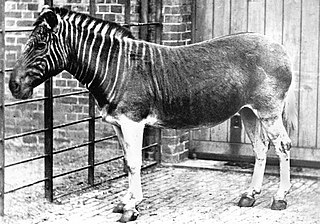
The quagga is an extinct subspecies of the plains zebra that was endemic to South Africa until it was hunted to extinction in the late 19th century. It was long thought to be a distinct species, but early genetic studies have supported it being a subspecies of plains zebra. A more recent study suggested that it was the southernmost cline or ecotype of the species.
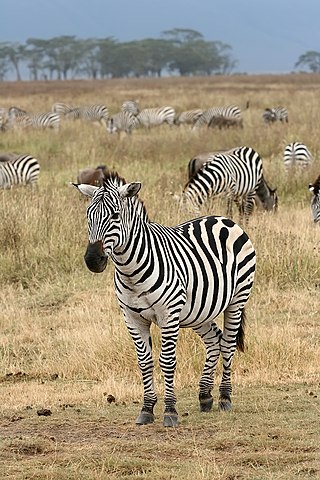
Zebras are African equines with distinctive black-and-white striped coats. There are three living species: Grévy's zebra, the plains zebra, and the mountain zebra. Zebras share the genus Equus with horses and asses, the three groups being the only living members of the family Equidae. Zebra stripes come in different patterns, unique to each individual. Several theories have been proposed for the function of these patterns, with most evidence supporting them as a deterrent for biting flies. Zebras inhabit eastern and southern Africa and can be found in a variety of habitats such as savannahs, grasslands, woodlands, shrublands, and mountainous areas.

The onager, also known as hemione or Asiatic wild ass, is a species of the family Equidae native to Asia. A member of the subgenus Asinus, the onager was described and given its binomial name by German zoologist Peter Simon Pallas in 1775. Six subspecies have been recognized, two of which are extinct.

The plains zebra is the most common and geographically widespread species of zebra. Its range is fragmented, but spans much of southern and eastern Africa south of the Sahara. Six or seven subspecies have been recognised, including the extinct quagga which was thought to be a separate species. More recent research supports variations in zebra populations being clines rather than subspecies.

The mountain zebra is a zebra species in the family Equidae, native to southwestern Africa. There are two subspecies, the Cape mountain zebra found in South Africa and Hartmann's mountain zebra found in south-western Angola and Namibia.

Breeding back is a form of artificial selection by the deliberate selective breeding of domestic animals, in an attempt to achieve an animal breed with a phenotype that resembles a wild type ancestor, usually one that has gone extinct. Breeding back is not to be confused with dedomestication.

The tarpan was a free-ranging horse subspecies of the Eurasian steppe from the 18th to the 20th century. It is generally unknown whether those horses represented genuine wild horses, feral domestic horses or hybrids. The last individual believed to be a tarpan died in captivity in the Russian Empire in 1909.

A zebroid is the offspring of any cross between a zebra and any other equine to create a hybrid. In most cases, the sire is a zebra stallion. The offspring of a donkey sire and zebra dam, called a donkra, and the offspring of a horse sire and a zebra dam, called a hebra, do exist, but are rare and are usually sterile. Zebroids have been bred since the 19th century. Charles Darwin noted several zebra hybrids in his works.
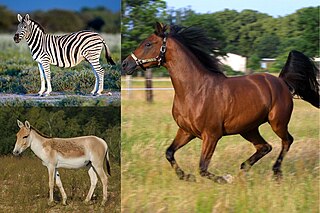
Equus is a genus of mammals in the family Equidae, which includes horses, asses, and zebras. Within the Equidae, Equus is the only recognized extant genus, comprising seven living species. Like Equidae more broadly, Equus has numerous extinct species known only from fossils. The genus most likely originated in North America and spread quickly to the Old World. Equines are odd-toed ungulates with slender legs, long heads, relatively long necks, manes, and long tails. All species are herbivorous, and mostly grazers, with simpler digestive systems than ruminants but able to subsist on lower-quality vegetation.

Burchell's zebra is a southern subspecies of the plains zebra. It is named after the British explorer and naturalist William John Burchell. Common names include bontequagga, Damaraland zebra, and Zululand zebra. Burchell's zebra is the only subspecies of zebra which may be legally farmed for human consumption.

Grant's zebra is the smallest of the seven subspecies of the plains zebra. This subspecies represents the zebra form of the Serengeti-Mara ecosystem and others across central Africa.
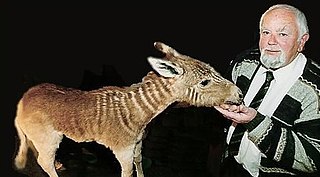
Reinhold Eugen Rau was a German natural historian who initiated the Quagga Project in South Africa, which aims to re-breed the extinct quagga, a sub-species of zebra.

The Cape mountain zebra is a subspecies of mountain zebra that occurs in certain mountainous regions of the Western and Eastern Cape provinces of South Africa.

Primitive markings are a group of hair coat markings and qualities seen in several equine species, including horses, donkeys, and asses. In horses, they are associated with primitive breeds, though not limited to such breeds. The markings are particularly associated with the dun coat color family. All dun horses possess at least the dorsal stripe, but the presence of the other primitive markings varies. Other common markings may include horizontal striping on the legs, transverse striping across the shoulders, and lighter guard hairs along the edges of a dark mane and tail.

Crawshay's zebra is a subspecies of the plains zebra native to eastern Zambia, east of the Luangwa River, Malawi, southeastern Tanzania, and northern Mozambique south to the Gorongoza District. Crawshay's zebras can be distinguished from other subspecies of plains zebras in that its lower incisors lack an infundibulum. Crawshay's zebra has very narrow stripes compared to other forms of the plains zebra.

Chapman's zebra, named after explorer James Chapman, is a subspecies of the plains zebra from southern Africa.

The Turkmenian kulan, also called Transcaspian wild ass, Turkmenistani onager or simply the kulan, is a subspecies of onager native to Central Asia. It was declared Endangered in 2016.

Khumba is a 2013 South African computer-animated comedy film directed and co-produced by Anthony Silverston and written by Silverston and Raffaella Delle Donne. The film stars the voices of Jake T. Austin, Steve Buscemi, Loretta Devine, Laurence Fishburne, Richard E. Grant, AnnaSophia Robb, Anika Noni Rose, Catherine Tate, Ben Vereen, and Liam Neeson. It is the second movie made by Triggerfish Animation Studios and is distributed by Millennium Entertainment in the US. The international distribution rights are being licensed by Cinema Management Group. The film is about Khumba, a zebra who is half-striped like a quagga and blamed for the lack of rain by the rest of his insular, abusive, superstitious herd, except his dad, mom and Tombi. He embarks on a quest to earn his stripes.
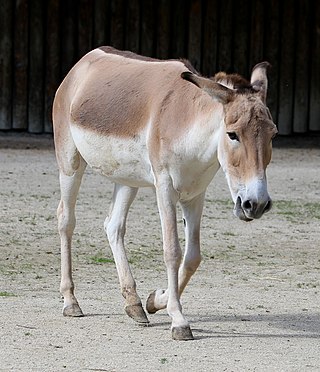
The Persian onager, also called the Persian wild ass or Persian zebra, is a subspecies of onager native to Iran (Persia). It is listed as Endangered, with no more than 600 individuals left in the wild and only 30 individuals living within North American institutions.
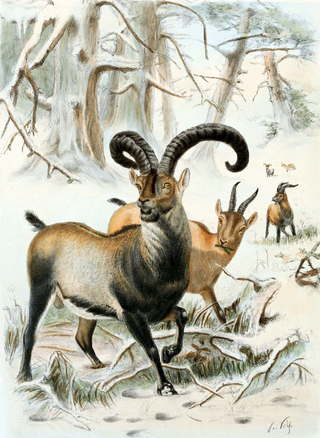
De-extinction is the process of generating an organism that either resembles or is an extinct species. There are several ways to carry out the process of de-extinction. Cloning is the most widely proposed method, although genome editing and selective breeding have also been considered. Similar techniques have been applied to certain endangered species, in hopes to boost their genetic diversity. The only method of the three that would provide an animal with the same genetic identity is cloning. There are benefits and drawbacks to the process of de-extinction ranging from technological advancements to ethical issues.